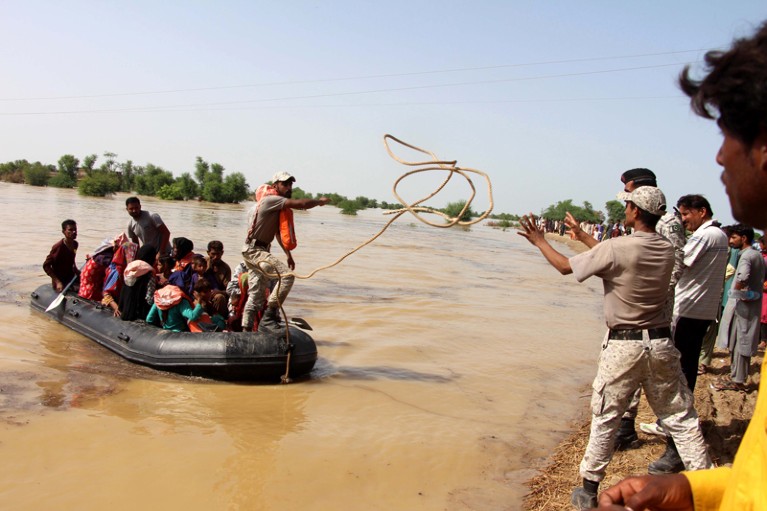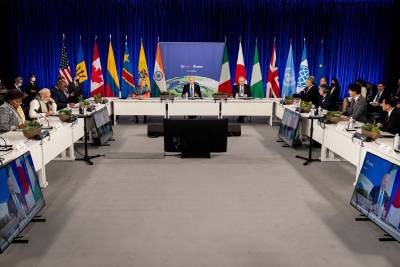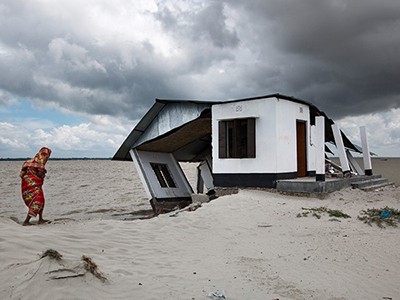
Climate adaptation finance is imperative for low- and middle-income countries, such as Pakistan, where floods have displaced millions this week.Credit: Waqar Hussain/EPA-EFE/Shutterstock
The next Conference of the Parties to the United Nations Framework Convention on Climate Change, COP27, is less than three months away. When world leaders meet in Sharm El Sheikh, Egypt, it will be only the fifth time such an event has been held in Africa — a continent already experiencing some of the most severe climate impacts — in three decades of climate diplomacy. But dark clouds are gathering before the meeting, which starts on 6 November, and there is a risk it will end in stalemate. Countries can and must act now to stop that from happening.
COP26 in Glasgow, UK, ended last November with a historic commitment by richer nations to provide low- and middle-income countries (LMICs) with US$40 billion annually in ‘adaptation finance’, from 2025. The funds are intended to help communities to protect themselves against the impacts of climate change, such as loss of life and the destruction of homes and farmland, as seen in Pakistan’s devastating floods.
The COP26 achievement was hard-won. Although it builds on a $100-billion annual climate-finance commitment made at COP15 in Copenhagen in 2009, most of this finance (around $83 billion annually) comes in the form of loans for mitigation projects to help stave off the worst impacts of climate change, for example by installing solar panels or wind farms to reduce fossil-fuel use — projects from which funders can expect a return. By contrast, adaptation schemes — strengthening flood defences or providing sunlight-reflecting cool roofs for households, for example — are best done by the public sector. This is why adaptation finance needs to be given as grants. But grants are harder to fund than are loans, which turn a profit for lenders.
‘COP26 hasn’t solved the problem’: scientists react to UN climate deal
That’s what made the COP26 pledge a valuable win for LMICs. However, LMIC leaders heading to Egypt expecting progress on the Glasgow commitment are likely to be disappointed. According to modelling by Clare Shakya and Jonathan Barnes, researchers at the International Institute for Environment and Development (IIED), a think tank in London, pledges made so far will take the projected total to just $21.8 billion annually by 2025 (see go.nature.com/3pubitg), just over half of the $40 billion target.
Separate analyses by groups including the IIED (see go.nature.com/3kmsqba) and the Global Center on Adaptation (GCA), based in Rotterdam, the Netherlands (see go.nature.com/3duyfbq), show that $40 billion is a small fraction of what is needed for communities to protect themselves adequately from severe climate impacts. The sum required would include funding to cover harms that have already occurred as a result of climate change — known collectively as ‘loss and damage’ finance.
Donor nations are supposed to report on progress towards meeting their pledges. Their funding estimates, compiled according to rules set by the rich-world Organisation for Economic Co-operation and Development (OECD), based in Paris, are likely to be higher than the IIED’s modelling suggests. Shakya, who is the IIED’s director for climate research, says this is because the institute’s analysis looks at new pledges and restricts its focus to funds that are specifically earmarked for climate adaptation. The donors, by contrast, tend to use a wider definition that includes money already committed, and funding for development projects — such as school buildings or clean-water infrastructure — that include a climate-protection component but are not primarily about climate.
The broken $100-billion promise of climate finance – and how to fix it
The OECD’s approach has been challenged by researchers and by LMIC governments, too. In 2015, researchers at India’s Ministry of Finance calculated figures much lower than those of the donors, for reasons similar to those that explain the discrepancy in estimates of adaptation finance (see go.nature.com/3rx5unp). According to the OECD’s latest data, published in July (see go.nature.com/3dzylqy), climate finance from high-income countries to LMICs increased from $58 billion in 2016 to $83 billion in 2020. But many LMICs are simply not confident about donor countries’ figures. “Trust is wearing thin,” Shakya told Nature. Next week, the GCA, together with the African Union, the African Development Bank and the International Monetary Fund, will host an adaptation meeting in Rotterdam to explore, among other things, how to break the deadlock.
As researchers — including Tracy Carty, senior policy adviser at the international-aid charity Oxfam and environmental scientist Romain Weikmans at the Free University of Brussels — have pointed out (R. Weikmans et al. Nature 588, 220; 2020), an important step is to agree on a definition of adaptation finance that all sides can accept. Such a process must be overseen by a trusted third party. This, regrettably, must rule out the OECD, on the grounds that it represents donor nations. That is no criticism of the OECD secretariat, nor of its researchers, who are doing the best they can within the boundaries set by the governments of high-income countries. Instead, the third party could be an arm of the UN, such as the Statistics Division, or an academic-research network, or a combination of the two. Crucially, it needs to be an entity in which everyone has a voice when decisions on methodology are made.
COPs are mostly fractious affairs, with success and failure hanging on 11th-hour, knife-edge decisions. COP27 will be no different. But there’s no sense in leaving discussions on adaptation finance until the meeting starts. Countries can and should make such discussions a priority now, with the assurance that researchers are ready to play their part.

 The broken $100-billion promise of climate finance – and how to fix it
The broken $100-billion promise of climate finance – and how to fix it
 Global climate action needs trusted finance data
Global climate action needs trusted finance data
 ‘COP26 hasn’t solved the problem’: scientists react to UN climate deal
‘COP26 hasn’t solved the problem’: scientists react to UN climate deal





